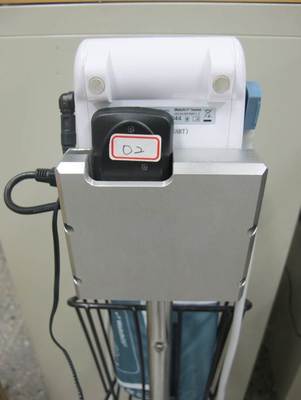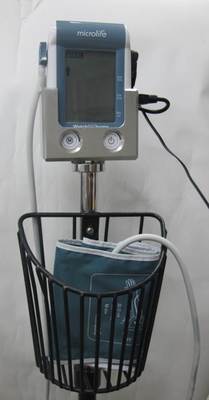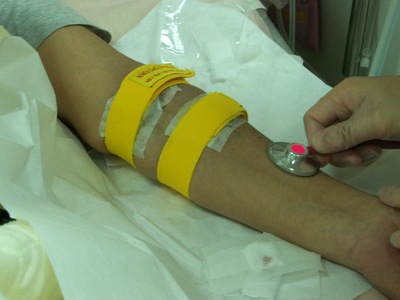Wireless physiological monitoring system a boon for dialysis patients



Tainan, Taiwan, Dec. 17, 2012
A wireless physiological monitoring system designed by the Department of Biomedical Engineering (BME) of National Cheng Kung University (NCKU), southern Taiwan, has proved to increase medical efficiency and safety for dialysis patients.
BME was invited by the Ministry of Education (MOE) to exhibit three of their new inventions -- the “i-Transport” carrier, the “Wireless Physiological Monitoring System for Hemodialysis” and the “Smart Tourniquet,” which have made revolutionary impact on the biomedical field -- at a recent forum.
BME, which was established just 2 years ago, has already produced results in the research and development of biomedical equipment, according to the university.
The “wireless physiological monitoring system for hemodialysis” was developed by NCKU BME Professor Tain-Song Chen. It helps dialysis centers monitor the physiological status of dialysis patients.
Besides providing warning signal during emergency in the hemodialysis process, the system also improves the safety level of the dialysis process because it allows one nurse to simultaneously monitor physiological parameters of 50 patients, thus helping to solve the problem of shortage of nursing staff, according to Dr. Chen.
He said that in the current dialysis process at dialysis centers, nurses and medical staff have to measure and record patients’ blood pressure every 30 minutes in order to monitor their physiological status.
Usually, quite a number of dialysis patients would be receiving dialysis treatment at the same time. Traditional steps to measure blood pressure of dialysis patients include tying the cuff, inflating it, deflating it and recording blood pressure – a process that usually takes two to three minutes.
Hence, one medical staff or nurse can only observe the blood pressure of approximately 10 to 15 patients provided the medical worker does not rest the whole working day. However, the new system enables one nurse to simultaneously monitor and observe blood pressure of 50 or more dialysis patients, said Chen.
This system uses Zigbee to set up a wireless transmission system. The reasons for using ZigBee, Chen said, are its low electricity consumption, low cost, its ability to support large amount of network nodes and different network topologies as well as its low complexity, high speed, high reliability, and high safety level.
By using ZigBee’s strengths to design a wireless blood pressure measurement system, the device can simultaneously measure and monitor the blood pressure of several dialysis patients with high measurement accuracy, according to Chen.
One medical staff is able to use remote monitoring system to monitor the physiological status of numerous patients, thus avoiding the need for medical staff to make visits to take blood pressure measurements, Chen noted. “This could reduce the burden of medical staff and nurses as well as enhance the quality of medical services.”
Chen said, this measurement system uses the wireless measurement network set up by ZigBee and measuring command can be issued using this system. After completing the measurement, the blood pressure readings will be sent via the wireless network back to the central nursing station, and then processed and analyzed by the monitoring platform which combines this system with a big computer system.
When physiological status of a patient is detected to be showing abnormal values, the system will issue a warning signal to enable medical staff and nurses take immediate measures to reduce the incidence of injury.
A wireless physiological monitoring system designed by the Department of Biomedical Engineering (BME) of National Cheng Kung University (NCKU), southern Taiwan, has proved to increase medical efficiency and safety for dialysis patients.
BME was invited by the Ministry of Education (MOE) to exhibit three of their new inventions -- the “i-Transport” carrier, the “Wireless Physiological Monitoring System for Hemodialysis” and the “Smart Tourniquet,” which have made revolutionary impact on the biomedical field -- at a recent forum.
BME, which was established just 2 years ago, has already produced results in the research and development of biomedical equipment, according to the university.
The “wireless physiological monitoring system for hemodialysis” was developed by NCKU BME Professor Tain-Song Chen. It helps dialysis centers monitor the physiological status of dialysis patients.
Besides providing warning signal during emergency in the hemodialysis process, the system also improves the safety level of the dialysis process because it allows one nurse to simultaneously monitor physiological parameters of 50 patients, thus helping to solve the problem of shortage of nursing staff, according to Dr. Chen.
He said that in the current dialysis process at dialysis centers, nurses and medical staff have to measure and record patients’ blood pressure every 30 minutes in order to monitor their physiological status.
Usually, quite a number of dialysis patients would be receiving dialysis treatment at the same time. Traditional steps to measure blood pressure of dialysis patients include tying the cuff, inflating it, deflating it and recording blood pressure – a process that usually takes two to three minutes.
Hence, one medical staff or nurse can only observe the blood pressure of approximately 10 to 15 patients provided the medical worker does not rest the whole working day. However, the new system enables one nurse to simultaneously monitor and observe blood pressure of 50 or more dialysis patients, said Chen.
This system uses Zigbee to set up a wireless transmission system. The reasons for using ZigBee, Chen said, are its low electricity consumption, low cost, its ability to support large amount of network nodes and different network topologies as well as its low complexity, high speed, high reliability, and high safety level.
By using ZigBee’s strengths to design a wireless blood pressure measurement system, the device can simultaneously measure and monitor the blood pressure of several dialysis patients with high measurement accuracy, according to Chen.
One medical staff is able to use remote monitoring system to monitor the physiological status of numerous patients, thus avoiding the need for medical staff to make visits to take blood pressure measurements, Chen noted. “This could reduce the burden of medical staff and nurses as well as enhance the quality of medical services.”
Chen said, this measurement system uses the wireless measurement network set up by ZigBee and measuring command can be issued using this system. After completing the measurement, the blood pressure readings will be sent via the wireless network back to the central nursing station, and then processed and analyzed by the monitoring platform which combines this system with a big computer system.
When physiological status of a patient is detected to be showing abnormal values, the system will issue a warning signal to enable medical staff and nurses take immediate measures to reduce the incidence of injury.
Provider:
新聞中心
Date:
101.12.12